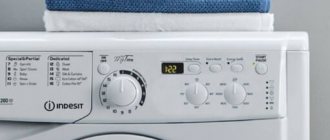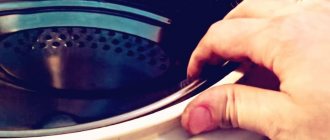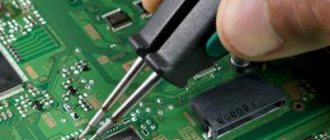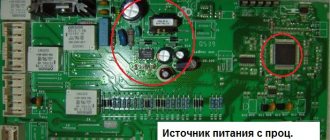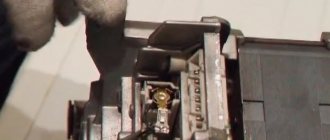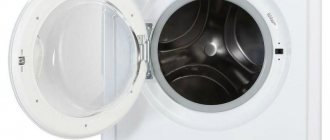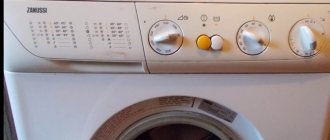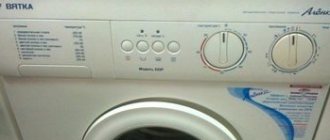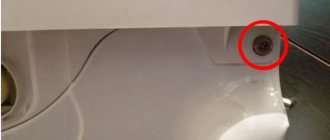Buying a washing machine is quite an expensive business. You spent a long time choosing the right model based on parameters and characteristics, comparing prices from different manufacturers, maybe even saving money. That's why you expect your au pair to work for a long time without interruption. But even the most expensive equipment can fail. Well, don’t get too upset ahead of time. It is possible that the cause of the malfunction is actually not very serious and you can fix it yourself. And even if this fails, it’s still too early to give up on your equipment - an experienced service technician will most likely be able to carry out repairs and eliminate the malfunction. First, you can try to determine the reason why the washing machine does not stop.
How exactly does the washing machine not turn off?
Observe the washing cycle - at what stage does the washing machine begin to “slip”? Is this the first time this has happened, or has this error been repeated several times?
- Let’s say the washing process itself went smoothly, but at the stage of draining the water some difficulties arose and the machine continues to spin the laundry, stop, click, then spin again and so on ad infinitum...
- Another case: washing became very long, the process time increased several times. In some cases, it does not stop washing at all and does not drain the water.
- Or the water has drained, but for some reason the machine does not turn on the spin mode, but continues to spin clothes in the drum without water.
- Another option: having completely completed the wash, rinse and spin cycle, the machine starts the entire cycle again from the very beginning.
To stop this endless process, you have to disconnect the machine from the power supply by removing the plug from the socket. Let's look at what causes each of these problems.
Reasons why the Indesit washing machine freezes during rinsing and spinning
The reasons why the Indesit washing machine may freeze during rinsing or spinning often overlap with those that lead to it stopping at the washing stage. These include:
Damage to the sensor that controls the balance of the laundry (it is not available in all models).
If the device is equipped with this component and it fails, the spin cycle will not start, since the control board will not receive a signal that all systems are working.If the sensor breaks, it will have to be replaced. Most often it is located in one of the shock absorbers.
- Damage to the shock absorber . They fail due to excessive vibration or prolonged use of the device. It's easy to replace it yourself. However, if one shock absorber breaks down, the second part will also have to be replaced.
- Failure of the tachometer responsible for speed control. If it fails, the control board cannot understand what the spin speed is, so it stops the process. A part needs to be replaced. The tachometer is located on the motor shaft. To get to it, you will have to remove the back cover of the washing machine.
Reasons that can lead to the washing machine freezing during spinning and rinsing, as well as during washing (their solutions were described above):
- failure of the pressure switch - the water level sensor is located under the cover;
- disturbances in the functioning of the water drainage system;
- control board failure.
The washing machine does not drain water
The most common reason for this is a broken drain pump. Or the pump blades are blocked by a foreign object that has gotten into them - a coin forgotten in a pocket, a key, etc. Until the water drains, the washing machine cannot unlock the door, so it does not turn off. To check whether the drain pump is really the cause, you can drain the water through the drain filter. If after this the machine turns off, that means it’s the problem. If not, then this is an electronic failure. It is better to entrust it to a specialist to replace or unblock the drain pump. Moreover, electronics repair.
Prevention of breakdowns
Frequent breakdowns of household washing machines can only be caused by improper operation. In order not to blush in the presence of the master and not to incur unexpected expenses, you just need to follow the instructions included with the unit. The list of recommendations can be very long, but the basic rules are as follows:
- do not expose the machine to shocks during transportation;
- install it only on a flat horizontal surface, taking the time to adjust the legs;
- do not overload the tank beyond normal limits;
- use high-quality powders and do not pour in corrosive compounds unnecessarily;
- when using hard water, minimize washing at temperatures above 70 °C;
- clean filters regularly;
- keep all internal cavities dry and clean;
- At the first sign of a malfunction, eliminate its cause so as not to lead to a serious breakdown.
Watch a video on how to fix washing machine problems yourself
The washing process is endless or takes too long
There may be several options here.
- Option one - the heating element (heating element) has partially or completely burned out. The water does not heat up at all or very slowly, so the automation does not give a signal to spin and continue the cycle - the clothes were not washed in cold water! It is necessary to replace the heating element with a new one.
- Option two: the water drain hose is lying on the floor. The heated water is gradually drained into the sewer system, and sensors send a signal to add more water. Thus, the heating element does not have time to heat the water to the required temperature, so the process is delayed or becomes non-stop. You need to secure the drain hose higher or do the correct installation of connecting the washing machine to the water with the help of an experienced technician.
- Option three: the electronic control module is frozen or broken. A non-specialist cannot solve such a problem on his own. The module needs to be rebooted or repaired, and its complete replacement is not excluded.
The heating element has failed
The heating element of the machine (heating element) may sooner or later fail or simply oxidize. As a result, the water that is poured into the tank will take longer to heat up than usual or will not heat up at all. The start of washing will be constantly delayed.
The solution to the problem is obvious - you need to disassemble the SM, get to the heating element, check its functionality, and, if necessary, either clean it of dirt or replace it with a new one.
By the way, you can diagnose a problem with a heating element without revealing the equipment. As a rule, with modern models, in case of malfunctions, an error code is displayed on the display. Each brand of washing machine has its own list of error codes. For example, for a heating element malfunction, the error “HE” corresponds. For more information on this topic, see the section on our website: “Error codes”.
The program does not turn off, the wash starts again
Here the problem can only be in the programmer or control board. The command to end the wash does not go through, so the washing machine starts all over again. We need diagnostics of the entire electronic control module and its subsequent repair or replacement.
As you can see from this review article, there may be several reasons for the washing machine not turning off. Some of these reasons can be eliminated with your own hands, but in most cases you will need help. It is possible and necessary to extend the life of your washing machine, but to do this you should contact good craftsmen for whom repairing washing machines is their narrow specialization. Our service repairs the most popular brands of automatic washing machines from such manufacturers as LG, Samsung, Indesit, Electrolux, Bosch, Ardo, Whirlpool, Siemens, Zanussi, Beko and some others. To make washing your clothes a joy, inexpensive and high-quality repairs with a guarantee at home are just what you need. Contact us and we will help you!
The main typical breakdowns and options for their elimination
It is difficult for a non-specialist to determine exactly why a washing machine that had always worked properly suddenly broke down. But deviations from normal operation are detected immediately. You should not try to make any manipulations with the internal structure of the device without proper qualifications, and you should pay close attention to external manifestations of the problem.
Advice! When calling a technician to your home, it is advisable to clearly formulate the symptoms of the malfunction. In this case, knowing them and the make of your model, he will most likely be able to prepare well for the visit by bringing the necessary spare parts.
The machine does not turn on
The most common symptom of a problem can indicate many reasons:
- The voltage in the external network has disappeared. By checking the lack of power to other electrical appliances in the house, you will be convinced that the machine is not to blame. Sometimes, due to a burnt-out light bulb, the machine at the entrance to the room is triggered. In this case, it is enough to simply move the toggle switch to the working position. If there is no phase to the input panel, you should contact utility services;
- The socket from which the machine is powered is faulty. Try connecting any other household appliance to it. If it shows no signs of life, check the reliability of the contacts. Sometimes it turns out that the plug was simply not inserted;
- The automation of modern models does not allow starting the device in the event of incorrect operator actions. A poorly closed hatch is a good reason for blocking. To turn it on, it is enough to open and carefully close the door again;
- Malfunction of the control unit or other elements of the internal electrical circuit. A special case of this may be a short circuit or the appearance of a leakage current. Then the automatic circuit breaker or residual current device (RCD) at the entrance to the apartment will operate. Disconnect the device from the network and immediately call a specialist.
If the machine does not turn on, check the voltage in the external network
The door does not open
Sometimes, at the end of the washing program, it is impossible to open the hatch and unload the laundry. There are two main reasons for such a breakdown of the washing machine:
- The lock interlock does not turn off due to the presence of water in the tank or a malfunction of the level sensor;
- Mechanical failure of the handle or latch. Sometimes it is possible to unlock the latch by slightly tilting the device back with the top cover removed and the screws on the back wall loosened. In this case, you will have to reach with your hand to the lock from the inside through the top of the machine.
Car door won't open
On a note! Some models have a special cable for emergency release of the hatch. It is usually painted orange. It is located behind the lower front panel. Pull it and the door will open.
The program does not start
If you have loaded laundry and the machine refuses to start washing, you should:
- Check all the options from the “The machine does not turn on” section of this article;
- If you have a tester and are a qualified electrician, ring the contacts of the start button, input filter, hatch lock lock, and central microcircuit. The rejected element will have to be replaced.
If the program does not start, check all the options from the section “The machine does not turn on”
The machine does not fill with water
The lack of water flow, provided that the connection is correct and the required inlet pressure is available, can be caused by several reasons:
- The mechanical filter is clogged. To restore the fluid supply, simply unscrew the pressure hose clamp nut, remove and wash the mesh;
- The solenoid valve is faulty. It is easier to replace than to repair;
- Incorrect operation of the water level sensor in the drum. It is better to entrust its repair or replacement to a specialist.
Clogged washing machine filter
Water does not heat up
The main breakdowns of household washing machines are associated with the failure of heating elements (heating elements) operating in intensive mode. To make sure of this, you need to:
- check the presence of water in the tank;
- select a program that requires heating to a temperature of more than 40 ° C;
- make sure that the machine is correctly connected to the electrical network, as evidenced by the switched on machine in the panel at the entrance to the apartment;
- After a few minutes, check by touching the sunroof glass for the presence or absence of heating.
Having run the circuit of the heating element with a tester, the technician usually comes to the conclusion that it is necessary to replace the heating element or thermostat.
The machine does not drain water
Lack of water pumping may indicate one of the typical reasons:
- Clogging of the sewer, which is confirmed by the lack of drainage from other plumbing fixtures connected to the same collector;
- The presence of deposits in the drain hose, which can be washed by turning on forced pumping with discharge into the bathtub or toilet;
- Clogging of the drain pump filter, which can be easily removed through the bottom hatch. You just need to unscrew it from its seat and clean it;
- Failure of the pump itself, which will have to be replaced using the services of a professional.
If the machine does not drain water, the drain may be clogged.
Attention! If the pumping line becomes depressurized, it is necessary to drain the remaining water into a prudently placed pan.
Spin problems
Incorrect spin or lack thereof occurs due to the following problems:
- After rinsing, water is not pumped out, which automatically prevents the drum from rotating at high speed. The causes and solutions to the problem are described in the previous section;
- The drum does not reach the required speed. The problem may be due to wear on the graphite brushes of the electric motor. They are consumables and are usually easily replaced with similar ones;
- The tachometer sensor, which is responsible for maintaining the required speed, is not functioning correctly. This device must be adjusted by a technician or completely replaced;
- Lack of drum rotation is a good reason for inspection and repair of the drive.
Puddles under the washer
The fact that the washing machine has suddenly broken down is indicated by the appearance of water flowing out from under the body. The reason for this may be excessive foaming or a violation of the tightness of elements filled with liquid during operation.
The cause of puddles under the washer may be excessive foaming
Important! In this case, you should not delay repairs, since there is a danger of a short circuit if solutions get on parts of the electrical circuit.
The most common leaks are:
- Hatch cuff;
- Places for attaching the supply or drain hose;
- Pumping unit.
Cars with a significant service life sometimes develop tank leaks. All such problems should only be corrected by a specialist.
Noise when the drum rotates quickly
The reasons for strong sounds when the machine is operating can be:
- Excessive loading;
- A foreign solid object gets into the drum;
- Counterweight shift;
- Bearing destruction.
If you do not find anything suspicious during your own inspection, call customer service.
Strong vibration and noise during operation
Strong vibration accompanied by extraneous noise indicates an imbalance in the weight balance or failure of any drive part. In this case, you should check:
- Play on bearings;
- Reliability of fastening of the drum and counterweights;
- The legs are adjusted correctly and the floor is level.
Advice! If the new machine makes sudden movements accompanied by a loud sound when first turned on after installation, check that the transport bolts have been removed.
Unpleasant smell from the machine
An unpleasant odor in the washing machine can occur for two reasons:
- Incorrect connection to the sewer system, which can be corrected by installing a check valve or water seal;
- Irregular use of equipment, the rubber parts of which may develop silt or mold. In this case, you will have to use disinfectants.
Use disinfectants to combat sludge or mold
Incorrect water supply
The machine may wash without stopping due to insufficient water supply due to the following reasons:
- no water or low pressure;
- The water supply valves are not fully open;
- the filter mesh is clogged;
- The water supply valve is broken.
What can be done:
- wait until the water pressure is good;
- open the valves completely;
- clean the filter on the supply hose;
- eliminate the inlet valve defect.
Thermistor or heating element
Under the influence of hard water, scale forms on the heating element of the washing machine. This leads to disruption of heat transfer from the element. Heating the water to the set temperature occurs very slowly, which lengthens the wash.
You can try to remove plaque from the heating element, for this:
- remove the top cover, remove the back wall of the case;
- disconnect the contacts of the heating element;
- loosen the central nut, push the screw;
- remove the heating element.
What to do next? There are various reagents for descaling. You can also try cleaning the surface with products available in every home. For example, soak the part in a solution of citric acid for a day, after which the coating should be easily cleaned off.
Be sure to test the heating element with a multimeter; if a faulty element is detected, the part will have to be replaced.
The reason that the cycle still does not stop may be a broken temperature sensor. When the water is heated to the desired degree, the thermistor transmits a signal to the control module, after which the “brain” turns off the heating element. The thermostat is located in the housing of the heating element; if it does not work correctly, the sensor must be replaced.
Some tips
If you want your washing machine to always please you with clean and fresh laundry, and the rinse mode to always turn on and work perfectly, follow these simple rules:
- use only high-quality detergents; cheap powders do not dissolve well in water;
- load the machine a little less than required according to the instructions, leave more free space;
- carefully check pockets and cuffs before washing, be sure to remove dirt and foreign objects;
- half an hour after the start of the washing process, touch the glass, make sure that the water in the machine has heated up to the desired temperature;
- use the “extra rinse” function without using rinse aid;
- At least once every six months, do preventative cleaning of the water intake and drainage systems, and also check the filters.
If you follow these simple rules, your home assistant will delight you with uninterrupted work for a long time.
See also:
- 10 best washing machines under 25,000 rubles according to customer reviews
- 13 best washing machines from 40,000 to 50,000 rubles according to customer reviews
- 14 most reliable washing machines
- 15 best washing machines
- 15 best washing machines from 30,000 to 40,000 rubles according to customer reviews
